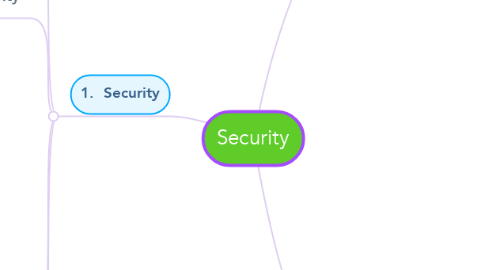
1. 1. Security
1.1. Properties
1.1.1. Confidentiality
1.1.2. Integrity
1.1.3. Avalibility
1.1.4. Consistency
1.1.5. Auditability
1.1.6. Control
1.1.7. Authentication
1.1.8. Non-repudiation
1.2. 5 steps to better security
1.2.1. 1. What protect assets
1.2.2. 2. Risk analysis
1.2.3. 3. How to protection risk
1.2.4. 4.What use tools
1.2.5. 5. Priorities or not
1.3. Information Enemies (Attacks)
1.3.1. 1. Passive Attack
1.3.1.1. Release of message content (ดักจับข้อมูลที่สำคัญหรือเป็นความลับแล้วนำไปเผยแพร่)
1.3.1.2. Traffic analysis : (นำข้อมูลไปวิเคราะห์เพื่อการกระทำในทางไม่ดี)
1.3.2. 2.Active Attack
1.3.2.1. Masquerade (การปลอมข้อความ โดยต้นทางที่ถูกแอบอ้างไม่เกี่ยวข้อง)
1.3.2.2. Modification of message (ดักจับข้อมูลจากต้นทาง แล้วแก้ไขข้อมูลก่อนส่งให้ปลายทาง)
1.3.2.3. Reply (ผู้บุกรุกจะทวนข้อความซ้ำที่ได้รับมาจากต้นทางเพื่อรบกวนการสื่อสาร ข้อความไม่ได้ถูกเปลี่ยนแปลง การยืนยันตัวตนถูกต้อง แต่จะทำให้ข้อความนั้นหมดอายุใช้งานไปแล้ว)
1.3.2.4. Denial of Service (ก่อกวน Server จนทำให้เครื่อง Server หรือเครือข่ายนั้นๆไม่สามารถให้บริการได้ )
1.4. Protective measures
1.4.1. 1. Prevention
1.4.2. 2. Detection
1.4.3. 3. Reaction/Response
2. 2. Authentications
2.1. Authentication Basic
2.1.1. Information
2.1.1.1. What the identity knows?
2.1.1.2. What the identity has?
2.1.1.3. What the identity is?
2.1.1.4. Where the identity is ?
2.1.2. Process
2.1.2.1. Obtaining information from the identity
2.1.2.2. Analyzing data
2.1.2.3. Determining if it associated with that identity
2.2. Passwords
2.2.1. Base on what people know
2.2.2. User supplies password
2.2.3. Password guessing
2.2.3.1. Dictionary attack
2.2.3.2. Random selection password
2.2.3.3. Password base on username, birthday etc.
2.3. Biometrics
2.3.1. Fingerprint
2.3.2. Voice
2.3.3. Eyes/Faces
2.3.4. Keystrokes
3. 3. Risk Management
3.1. Step of risk analysis process
3.1.1. 1. Assign value to assets
3.1.2. 2. Estimate potential loss per Threat
3.1.3. 3. Perform a Threat analysis
3.1.4. 4. Drive the overall loss potential per Threat
3.1.5. 5. Managing risks
3.2. Solutions
3.2.1. Accept
3.2.2. Mitigate
3.2.3. Transfer
3.2.4. Fix
3.3. Type
3.3.1. Physical damage
3.3.2. Human interaction
3.3.3. Equipment malfunction
3.3.4. Inside and outside attack
3.3.5. Misuse of data
3.3.6. etc.
